As Halloween approaches, the question of whether dogs can consume candy corn surfaces, prompting concerns among pet owners. With a vet's perspective on this seasonal treat, crucial insights are offered regarding the potential risks involved in sharing this Halloween classic with our canine companions.
Understanding the implications of key ingredients, particularly xylitol, sheds light on the importance of informed decision-making to safeguard our pets' well-being during festive occasions.
Stay tuned to learn more about the dangers lurking within these colorful confections and how best to protect your furry friends this Halloween.
Key Takeaways
- Candy corn poses serious health risks to dogs due to xylitol, sugar, and oils.
- Immediate veterinary care is essential if a dog ingests candy corn.
- Prioritize pet safety by avoiding giving candy to dogs during Halloween.
- Understand the dangers of xylitol poisoning and choose safer treats for dogs.
Potential Dangers of Candy Corn
Candy corn poses significant risks to dogs due to its toxic ingredients, including xylitol, which can lead to severe health complications such as hypoglycemia and liver damage. Other components like sugar, corn syrup, and oils in candy corn can also trigger gastrointestinal issues in dogs.
Even xylitol-free variations of candy corn remain unsafe for dogs, highlighting the potential health hazards associated with this popular Halloween treat. Accidental ingestion of candy corn can result in serious health complications, emphasizing the importance of pet owners being vigilant and proactive in keeping such items out of reach of their furry companions.
Immediate veterinary care is essential if a dog exhibits any signs of illness post-consumption to mitigate potential harm.
Harmful Ingredients in Candy Corn
The potential risks associated with candy corn consumption for dogs stem from the harmful ingredients it contains, particularly xylitol, sugar, corn syrup, and oils, which can lead to various health issues. Xylitol is a particularly dangerous ingredient found in candy corn, as it can cause hypoglycemia and liver damage in dogs.
Excessive sugar consumption can lead to obesity, diabetes, and dental problems in pets. Corn syrup, commonly found in candy corn, can cause gastrointestinal upset and potentially contribute to obesity. Additionally, the oils present in candy corn can lead to digestive disturbances in dogs.
It is crucial for pet owners to be aware of these harmful ingredients to safeguard their dogs' health during Halloween and other occasions when candy is prevalent.
Risks of Xylitol-Free Candy Corn
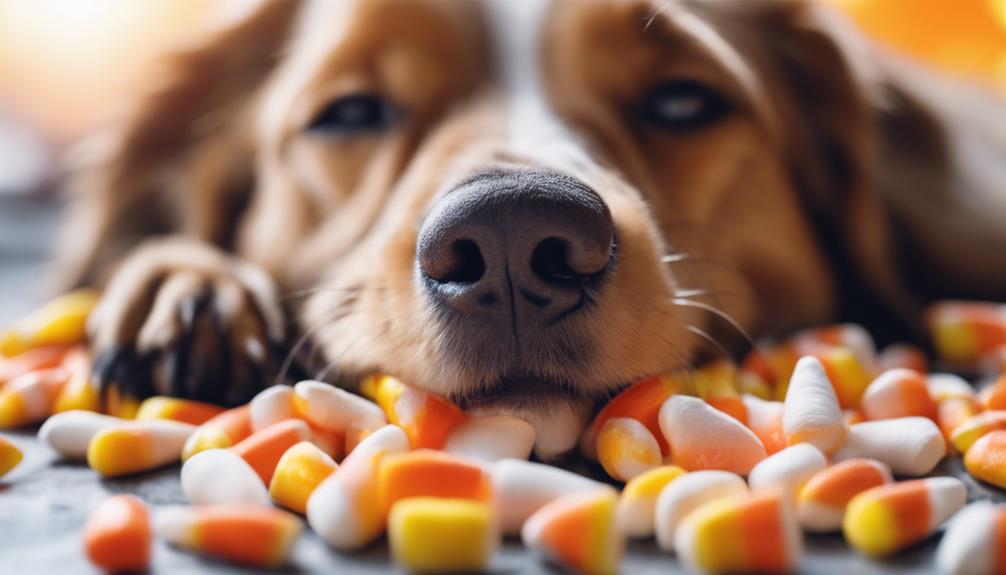
Despite the absence of xylitol, xylitol-free candy corn still poses health risks to dogs due to other potentially harmful ingredients contained within. Ingredients like sugar, corn syrup, artificial colors, and preservatives found in candy corn can lead to gastrointestinal upset in dogs. Excessive consumption of these ingredients may cause symptoms such as vomiting, diarrhea, and pancreatitis in canines. Additionally, the high sugar content in candy corn can contribute to obesity and dental issues in dogs over time.
Pet owners should be cautious and avoid feeding their dogs candy corn, even if it does not contain xylitol, to prevent potential health complications and ensure the well-being of their furry companions.
Health Complications From Candy Ingestion
Caution is paramount when considering the potential health complications that can arise from the ingestion of various types of candies by dogs. Consuming candies can lead to a range of issues for dogs, including:
- Digestive Upset: Ingredients like sugar, corn syrup, and oils commonly found in candies can cause gastrointestinal disturbances in dogs.
- Toxicity Risks: Candies containing toxic substances such as xylitol, chocolate, raisins, sweeteners, and oils can lead to severe health issues for dogs.
- Choking Hazards: Ingesting candies, along with wrappers and sticks, can pose a risk of choking or intestinal obstruction for dogs.
It's crucial to keep candies out of reach of pets to prevent these potential health complications.
Emergency Response for Dogs
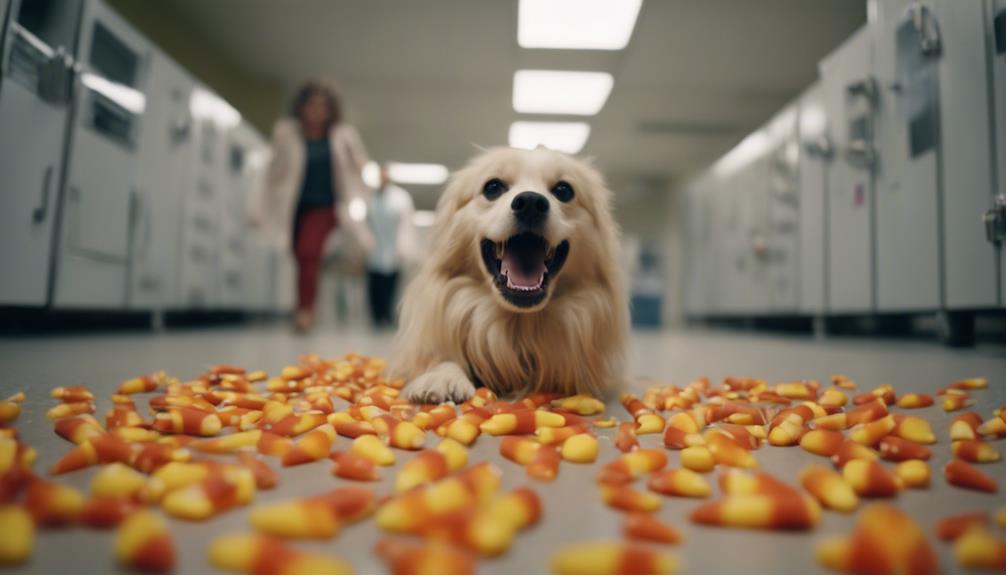
In cases of canine emergencies, swift and decisive action can be instrumental in ensuring the well-being of dogs.
If a dog ingests candy corn, it is crucial to react promptly. Firstly, try to locate the original packaging to identify the ingredients, especially xylitol content.
Contacting ASPCA Animal Poison Control or the Pet Poison Helpline for expert guidance is advisable. It is essential to understand that signs of illness may not immediately manifest after candy consumption, making vigilant monitoring imperative.
If any symptoms of sickness arise, seeking immediate veterinary care is paramount. With proper medical attention, most dogs can recover from xylitol poisoning.
Timely intervention and professional assistance are key in addressing emergencies related to candy ingestion in dogs.
Recovery From Xylitol Poisoning
After exposure to xylitol, dogs require immediate veterinary intervention to facilitate their recovery from poisoning. When a dog ingests xylitol-containing products like candy corn, the effects can be severe and potentially life-threatening. Here are key steps in the recovery process:
- Inducing Vomiting: Veterinary professionals may induce vomiting to remove any remaining xylitol from the dog's system.
- Monitoring Blood Glucose Levels: Regular monitoring of blood glucose levels is essential to manage hypoglycemia caused by xylitol ingestion.
- Supportive Care: Providing supportive care such as intravenous fluids, liver protectants, and close monitoring can aid in the dog's recovery process.
These interventions are crucial in helping dogs overcome xylitol poisoning and preventing further complications.
Pet-Friendly Halloween Alternatives
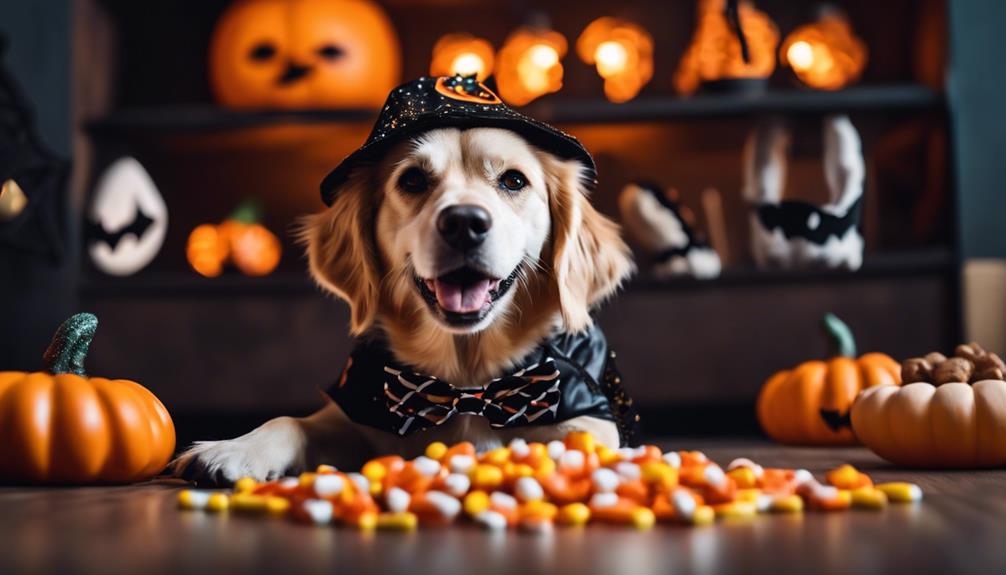
During the Halloween season, pet owners can explore safe and enjoyable alternatives to traditional treats for their furry companions. Instead of offering candies that can be harmful to pets, consider providing pet-friendly Halloween alternatives such as specially formulated dog treats, chew toys, or interactive puzzle toys filled with pet-safe treats.
You can also engage in Halloween-themed activities with your pet, like dressing them up in a cute costume, going on a fun walk to enjoy the fall weather, or organizing a pet-friendly Halloween party with other pet owners. These alternatives can help ensure that your pet stays safe and happy during the Halloween festivities while still enjoying the spirit of the season.
Safe Human Foods for Dogs
Exploring safe and nutritious dietary options for dogs, particularly during festive occasions like Halloween, involves understanding the spectrum of human foods that can benefit their health and well-being. When considering safe human foods for dogs, it's essential to prioritize their nutritional needs and avoid ingredients that could be harmful. Here are some examples of safe human foods for dogs:
- Cooked lean meats like chicken, turkey, or beef provide high-quality protein without added seasonings or bones.
- Fresh fruits such as apples (without seeds), blueberries, and watermelon offer vitamins and antioxidants.
- Vegetables like carrots, green beans, and sweet potatoes are rich in fiber and can be served steamed or raw as healthy snacks.
Understanding Food Risks for Pets
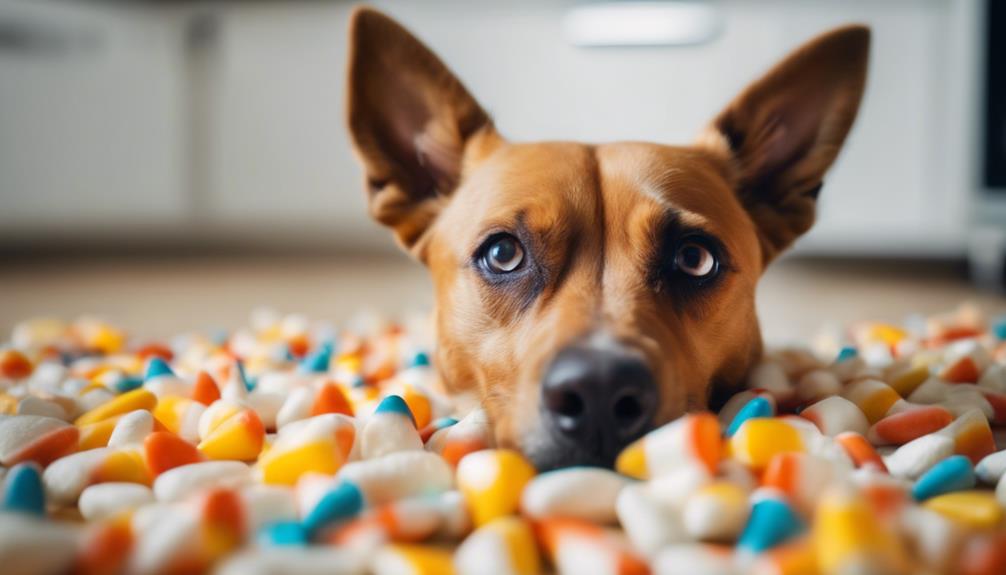
Understanding the potential risks associated with various foods is essential for ensuring the well-being and safety of pets. When it comes to feeding our furry friends, it is crucial to be aware of the potential dangers certain foods can pose to their health.
Foods like chocolate, grapes, onions, garlic, and foods containing xylitol are toxic to dogs and can lead to severe health issues if ingested. In addition, bones, fatty foods, and certain spices can also be harmful to pets.
Safe Treats for Dogs
When considering suitable treats for dogs, prioritizing their health and safety is paramount. Here are some safe options to consider:
- Carrots: Crunchy and low in calories, carrots are rich in vitamins and fiber, making them a healthy treat for dogs.
- Blueberries: Packed with antioxidants and vitamins, blueberries are a sweet treat that can benefit a dog's immune system.
- Pumpkin: High in fiber and low in fat, pumpkin can aid in digestion and promote overall gut health in dogs.
These alternatives not only satisfy your dog's cravings but also contribute to their well-being. Remember to introduce new treats gradually to monitor any potential allergies or sensitivities.
Preventing Xylitol Poisoning
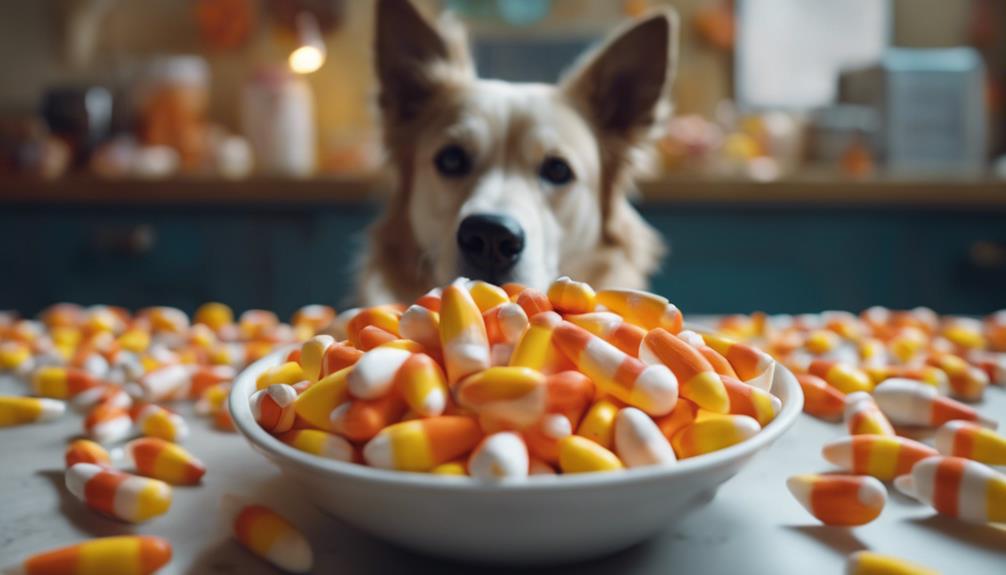
To safeguard your dog's health, proactive measures must be taken to prevent xylitol poisoning, a serious risk associated with various everyday products. Xylitol, commonly found in sugar-free gum, candies, and baked goods, can cause hypoglycemia, liver failure, and even death in dogs.
To prevent xylitol poisoning, pet owners should carefully read ingredient labels on all products before sharing any food with their pets. It's crucial to keep xylitol-containing items out of reach of dogs and to store them securely. If accidental ingestion occurs, immediate veterinary care is necessary.
Awareness and diligence in identifying and avoiding xylitol-containing products can go a long way in protecting your furry companion from this potentially fatal toxin.
Audience Engagement Strategies
Implementing effective audience engagement strategies is paramount for maximizing the reach and impact of content across various platforms. To enhance audience interaction and understanding, consider the following strategies:
- Utilize Interactive Content: Engage audiences through quizzes, polls, contests, and surveys to encourage participation and feedback.
- Personalize Communication: Tailor content based on audience preferences, behavior, and demographics to foster a deeper connection.
- Encourage Community Building: Create forums, social media groups, or live Q&A sessions to facilitate discussions, share insights, and build a sense of belonging among followers.
Conclusion
In conclusion, the dangers of candy corn for dogs, particularly due to harmful ingredients like xylitol, highlight the importance of pet owners being vigilant and informed during Halloween festivities.
Understanding the risks of candy ingestion and taking prompt action in response to potential emergencies can help safeguard the well-being of our furry companions.
By prioritizing pet safety and offering alternative treat options, responsible pet care practices can be promoted to ensure the health of our beloved pets.




